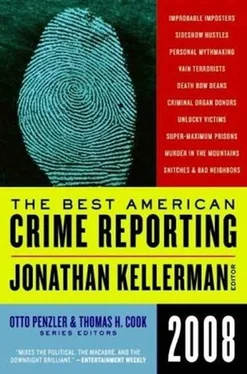“He’s got a pretty impressive network,” says Terry Rearick, a California private investigator who has communicated with Silverstein by letter and phone over several years. After the two lost touch for a time, Rearick got a call from a woman in England on Silverstein’s behalf.
The same woman posts regularly on the website, where Silverstein himself duels at length with his detractors. (A similarly heated debate has ignited over the wording of Silverstein’s entry on Wikipedia; his defenders and his critics alternately revise the account to suit their competing versions of his crimes.) Some visitors to his site dismiss him as a textbook psychopath. But Silverstein contends that if people understood the grim context in which the killings at Marion took place, the snitch games and psychological warfare and organized violence of prison life, they wouldn’t be so quick to demonize him.
It’s a strangely disconnected argument-a garbled dialogue between cultures on different planets. Most of the visitors to his website know little about Silverstein’s world, just as he knows little about theirs. He’s been in prison for the past 32 years, and much of what he’s learned about life on the street since he was put in solitary in 1983 has come from reading or watching television. No American prisoner, not even Robert Stroud, the Birdman of Alcatraz, has ever been condemned to such a walled-off existence for such a long period of time. Many of Stroud’s years of solitary confinement were spent in relative ease at Leavenworth; he had not only frequent visitors, but also a full-time secretary. Even his seventeen-year stretch in Alcatraz allowed for much more daily communication with others than Silverstein has had.
“I’m amazed that he’s not stark, raving mad,” says Paul Wright, the editor of Prison Legal News , who’s corresponded with Silverstein for years and published some of his writing. “He’s been in total isolation for almost 25 years. The only people I can think of that have been held in anything remotely like this in modern times are some of the North Korean spies held in South Korea.”
Yet the no-contact conditions imposed on Silverstein are becoming less unique by the day. There are now 31 supermax prisons in the country, with more under construction, including Colorado’s own 948-bed sequel to the current state supermax, known as Colorado State Penitentiary II. They are costly on several levels-the operational expense per cell can be double that of a less-secure prison, and the rate of mental illness in solitary confinement far exceeds that of the general prison population-but lockdown prisons are all the rage with a vengeful public. Increasingly, they are being used not for short-term punishment (disciplinary segregation) but for long-term confinement of hard-to-manage inmates (administrative segregation), whose privileges keep shrinking. Colorado, for example, no longer allows journalists to interview its supermax inmates except by mail.
“The phenomenon is disturbingly common,” says David Fathi, a staff attorney for the ACLU’s National Prison Project. “If it’s disciplinary confinement, it’s finite-when you’re done, you’re done. But with administrative segregation, there’s a real lack of transparency about what a prisoner can do to earn his way out.”
In the federal system, the past decade has seen the rise of “special administrative measures,” or SAMs, which are imposed on terrorists or other inmates whose communications with the outside world “could result in death or serious bodily injury to persons.” There are now at least two dozen SAMs cases in federal prisons, including Yousef and Zacarias Moussaoui, whose access to mail, phone calls, media interviews or other visits are extremely limited or banned outright. At present the restrictions must be approved by the U.S. Attorney General, but the Bush administration is considering changes that would allow wardens at ADX or other high-security prisons to designate inmates as terror threats and thus ban them from all media contact-even if they haven’t been convicted on terrorism charges yet, Fathi notes.
Silverstein isn’t a SAMs case. He still has his website and his mail (although he claims it’s frequently withheld or “messed with” in other ways). But he may be the prototype of what the government has in mind for other infamous prisoners-to bury them in strata of supermax security to the point of oblivion.
Responding in letters to questions about the psychological impact of his isolation, Silverstein struggles to find the right words. “Trying to explain it is like trying to explain what an endless toothache feels like,” he writes. “I wish I could paint what it’s like.”
In an article a few years ago, he called solitary confinement “a slow constant peeling of the skin, stripping of the flesh, the nerve-wracking sound of water dripping from a leaky faucet in the still of the night while you’re trying to sleep. Drip, drip, drip, the minutes, hours, days, weeks, months, years, constantly drip away with no end or relief in sight.”
IN A DARWINIAN WORLD, predators have to adapt or die, just like their prey. Tommy Silverstein arrived in the federal prison system at a critical phase of its evolution, when the number of inmate assaults on other inmates and staff was rising sharply and officials were looking at the idea of control units as a way to neutralize the growing threat posed by prison gangs. Silverstein quickly became a symbol of the problem-and the inadequacy of the proposed solution. It’s not a stretch to say that the Marion control unit helped to make him what he became, just as the mayhem that erupted there helped to reshape the American prison system.
Before he reached the nether regions of the BOP, Silverstein’s criminal career had been thoroughly unremarkable. Born in 1952 in California, he’d grown up in a middle-class neighborhood in Long Beach, but he was bullied by other kids who thought he was Jewish. (According to The Hot House, Silverstein’s biological father was a man named Thomas Conway, whom his mother divorced when Tommy was four years old; she later married a man named Silverstein.) As a teenager, he ripped off houses for money to buy drugs; his sister, Sydney McMurray, says he was battling a heroin addiction and problems with his volatile, controlling mother.
“We were taught never to throw the first punch, but never to walk away from a fight,” McMurray recalls. “My brother started getting into trouble because he was running away from a violent environment at home. Then he got into drugs, and he became a brother I never knew.”
Silverstein graduated from burglary to armed robbery. He was soon arrested for a series of hold-ups-pulled with Conway and another relative-that yielded less than $1,400. He was sentenced to a federal prison for fifteen years. He was 23 years old, and his life on the streets was already over.
At Leavenworth, Silverstein became closely associated with Aryan Brotherhood members who allegedly controlled the heroin trade inside the prison-close enough that when convict Danny Atwell was found stabbed to death, supposedly because he’d refused to be a mule for the heroin business, Silverstein and two other AB members were charged with the murder. In 1980, he was convicted at trial on the basis of shifting testimony from other inmates and sentenced to life in prison. A federal appeals court later ruled that much of the testimony should never have been allowed and threw out the conviction. But by that time, Silverstein was in the Marion penitentiary and facing more murder charges.
Marion opened in 1963, the same year that Alcatraz closed. It was intended to be not just a replacement for the Rock but an improvement, with a more open design and modern rehabilitation programs. Yet by the late 1970s, it had the most restrictive segregation unit in the BOP; not coincidentally, it was also the most violent prison in America, a dumping ground for gang leaders and crazies. Between 1979 and 1983, the prison logged 81 inmate assaults on other inmates and 44 on staff; 13 prisoners were killed. BOP reports issued in 1979 and 1981 proposed turning the entire facility into a “closed-unit operation.”
Читать дальше












